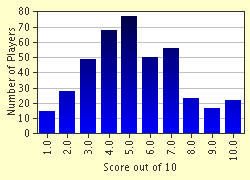Quiz Answer Key and Fun Facts
1. The dragonfly, and damselfly, are members of which Order of the Insecta Group?
2. Which of the following is NOT a difference between dragonflies and damselflies?
3. What is the average cruising speed of a dragonfly?
4. An old name for the damselfly is?
5. Do dragonflies have antennae?
6. The life cycle of the dragonfly goes from egg to larva to emergence as an adult. Most of the dragonfly's life is spent at which stage?
7. In the United Kingdom, dragonflies are often called 'Horse-Stingers'. Dragonflies do have stingers. True or False?
8. Dragonflies are among the most ancient of living creatures. They go back to Carboniferous times, meaning they were flying more than how many years ago?
9. The largest wingspan of a living dragonfly is about 19 cm. It is called the Megaloprepus coerulatus and is found where?
10. By digging small ponds in our gardens and backyards we can help encourage the spread of the dragonfly species. True or False?
Source: Author
catnippin
This quiz was reviewed by FunTrivia editor
gtho4 before going online.
Any errors found in FunTrivia content are routinely corrected through our feedback system.

